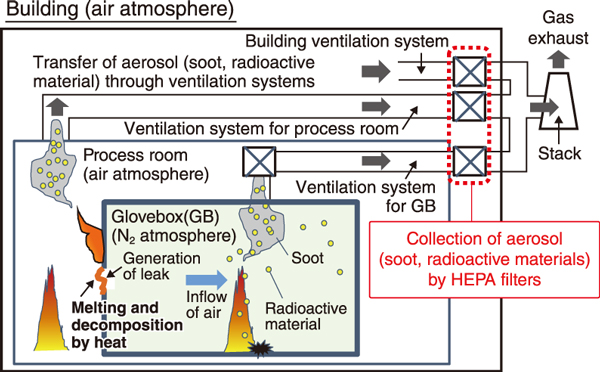
Fig.1 Schematic diagram of the location of the high-efficiency particulate air (HEPA) filters that confine radioactive materials within the facility and the state of transfer of soot and radioactive aerosol through the ventilation system induced by a glovebox fire accident

Fig.2 Relationship between the differential pressure (ΔP) and the amount of soot loading on the HEPA filter: (a) ΔP vs. the loading mass of soot (Mp) and (b) ΔP vs. the loading volume of soot (Vp)
For a mixed oxide (MOX) fuel fabrication facility, the loss of confinement is listed as one of the severe accidents in the regulatory standard of Japan. The confinement function is realized by (1) a negative pressure by ventilation inside the facility and the glovebox (GB) for radioactive powder with high dispersibility and (2) the elimination of radioactive aerosols by the high-efficiency particulate air (HEPA) filters in the ventilation systems, as shown in Fig.1. The GB panels include combustible components made of materials such as polymethyl methacrylate (PMMA) and/or polycarbonate (PC). In a fire accident of the GB panels, a massive amount of soot will be released, and this soot will migrate into the ventilated gas flow. Then, this soot may clog HEPA filters, raise their differential pressure (ΔP), causing leakage as their breakage limit of ΔP is exceeded. Since leakage from HEPA filters will severely affect the public, proper management of such accidents, for example, by changing the clogged HEPA filters, will be necessary. To examine the time margin to finish the accident management, fundamental data are necessary for calculating the time evolution of the rise of ΔP.
To evaluate the rise of ΔP across the HEPA filters under fire conditions, we need information on (1) the release behavior (i.e., amount and particle size distribution (PSD)) of soot from the combustion classified by the type of combustible materials, and (2) the relationship between ΔP and the amount of soot loading on the HEPA filter. We performed combustion tests of PMMA and PC for acquiring the above information. To obtain the relationship mentioned in (2), we tested different types of burnt samples and supplied-air flow rate (Fv) to the combustion cell of the test apparatus. In addition, ΔP data were experimentally acquired up to the value that guarantees the quality of the HEPA filter in Japanese Industrial Standards. As shown in Fig.2(a), no useful pattern was recognized. However, we proposed that the size (volume) of soot particles loaded on the HEPA filter contribute to the evolution of ΔP because the soot that experienced a higher temperature and a longer time at lower Fv values grows larger and assumes a complex shape. Based on the above consideration, the mass of soot loading on the HEPA filter (Mp), as shown in Fig.2(a) was converted into the loading volume (Vp) by summing up the instantaneous volume of soot calculated from the result of the number concentration of soot measured from the time-varying PSD; the measurement was performed by assuming spherical soot particles. As shown in Fig.2 (b), the following relationships of ΔP for a given Vp were identified: (i) For a given Vp, the ΔP for burning PC was larger than that for burning PMMA under identical Fv conditions. (ii) For a given Vp, the ΔP under a lower Fv condition was larger than that under a higher Fv condition. These relationships support the aforementioned consideration.
We will modify the evaluation model for ΔP vs. Vp to evaluate the rise in ΔP in a unified manner.
This study includes some results from works performed under the research entrusted by the Secretariat of Nuclear Regulation Authority, Japan.
(Shinsuke Tashiro)